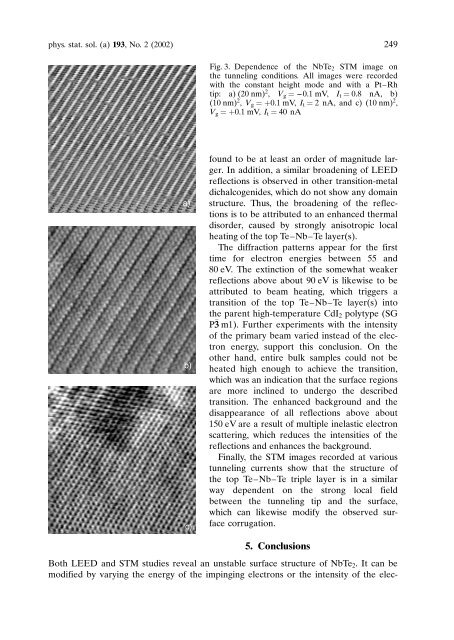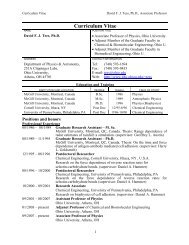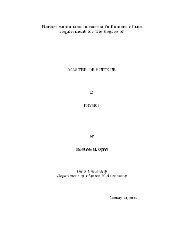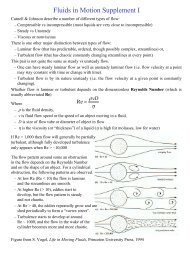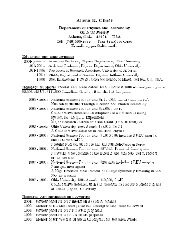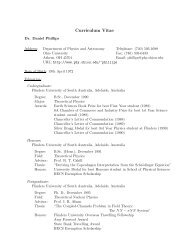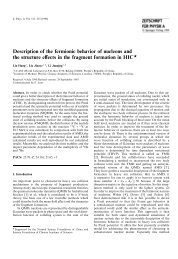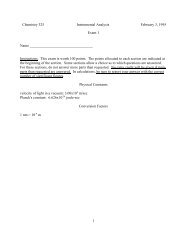The Instability of the NbTe2 Surface Structure D - Department of ...
The Instability of the NbTe2 Surface Structure D - Department of ...
The Instability of the NbTe2 Surface Structure D - Department of ...
You also want an ePaper? Increase the reach of your titles
YUMPU automatically turns print PDFs into web optimized ePapers that Google loves.
Both LEED and STM studies reveal an unstable surface structure <strong>of</strong> NbTe 2 . It can be<br />
modified by varying <strong>the</strong> energy <strong>of</strong> <strong>the</strong> impinging electrons or <strong>the</strong> intensity <strong>of</strong> <strong>the</strong> elecphys.<br />
stat. sol. (a) 193, No. 2 (2002) 249<br />
Fig. 3. Dependence <strong>of</strong> <strong>the</strong> NbTe 2 STM image on<br />
<strong>the</strong> tunneling conditions. All images were recorded<br />
with <strong>the</strong> constant height mode and with a Pt–Rh<br />
tip: a) (20 nm) 2 , V g ¼ –0.1 mV, I t ¼ 0.8 nA, b)<br />
(10 nm) 2 , V g ¼þ0.1 mV, I t ¼ 2 nA, and c) (10 nm) 2 ,<br />
V g ¼þ0.1 mV, I t ¼ 40 nA<br />
a)<br />
b)<br />
c)<br />
found to be at least an order <strong>of</strong> magnitude larger.<br />
In addition, a similar broadening <strong>of</strong> LEED<br />
reflections is observed in o<strong>the</strong>r transition-metal<br />
dichalcogenides, which do not show any domain<br />
structure. Thus, <strong>the</strong> broadening <strong>of</strong> <strong>the</strong> reflections<br />
is to be attributed to an enhanced <strong>the</strong>rmal<br />
disorder, caused by strongly anisotropic local<br />
heating <strong>of</strong> <strong>the</strong> top Te–Nb–Te layer(s).<br />
<strong>The</strong> diffraction patterns appear for <strong>the</strong> first<br />
time for electron energies between 55 and<br />
80 eV. <strong>The</strong> extinction <strong>of</strong> <strong>the</strong> somewhat weaker<br />
reflections above about 90 eV is likewise to be<br />
attributed to beam heating, which triggers a<br />
transition <strong>of</strong> <strong>the</strong> top Te–Nb–Te layer(s) into<br />
<strong>the</strong> parent high-temperature CdI 2 polytype (SG<br />
P 3 m1). Fur<strong>the</strong>r experiments with <strong>the</strong> intensity<br />
<strong>of</strong> <strong>the</strong> primary beam varied instead <strong>of</strong> <strong>the</strong> electron<br />
energy, support this conclusion. On <strong>the</strong><br />
o<strong>the</strong>r hand, entire bulk samples could not be<br />
heated high enough to achieve <strong>the</strong> transition,<br />
which was an indication that <strong>the</strong> surface regions<br />
are more inclined to undergo <strong>the</strong> described<br />
transition. <strong>The</strong> enhanced background and <strong>the</strong><br />
disappearance <strong>of</strong> all reflections above about<br />
150 eV are a result <strong>of</strong> multiple inelastic electron<br />
scattering, which reduces <strong>the</strong> intensities <strong>of</strong> <strong>the</strong><br />
reflections and enhances <strong>the</strong> background.<br />
Finally, <strong>the</strong> STM images recorded at various<br />
tunneling currents show that <strong>the</strong> structure <strong>of</strong><br />
<strong>the</strong> top Te–Nb–Te triple layer is in a similar<br />
way dependent on <strong>the</strong> strong local field<br />
between <strong>the</strong> tunneling tip and <strong>the</strong> surface,<br />
which can likewise modify <strong>the</strong> observed surface<br />
corrugation.<br />
5. Conclusions


